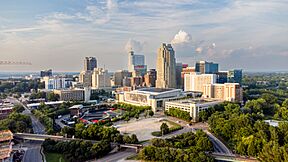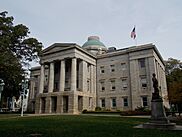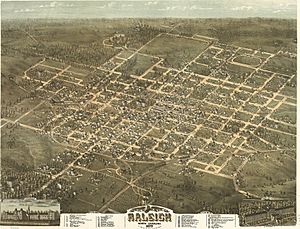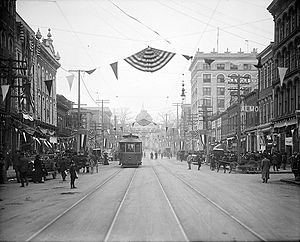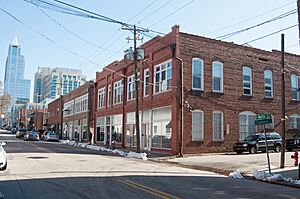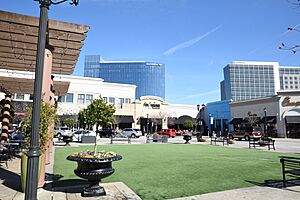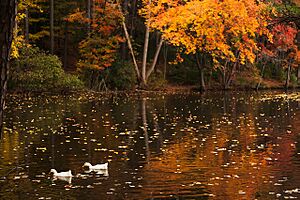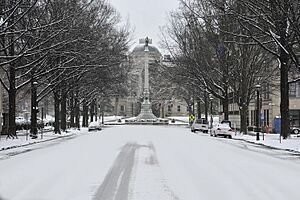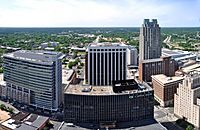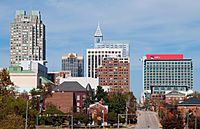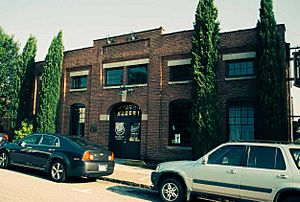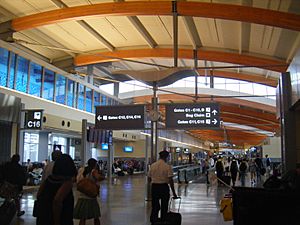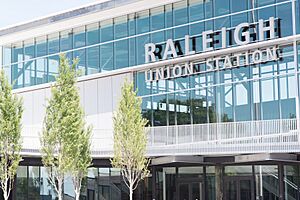Raleigh, North Carolina facts for kids
Quick facts for kids
Raleigh
|
|||||
|---|---|---|---|---|---|
|
Downtown Raleigh skyline
NCSU Belltower
Fayetteville Street
The Warehouse District
|
|||||
|
|||||
| Nickname(s):
City of Oaks, Raleigh Wood, Oak City
|
|||||
| Motto(s):
Amore et Virtute (Latin for "by Love and Virtue")
|
|||||
| Country | United States | ||||
| State | North Carolina | ||||
| Counties | Wake, Durham | ||||
| Chartered | December 31, 1794 | ||||
| Named for | Sir Walter Raleigh | ||||
| Government | |||||
| • Type | Council–manager | ||||
| • Body | Raleigh City Council | ||||
| Area | |||||
| • Total | 149.60 sq mi (387.50 km2) | ||||
| • Land | 148.54 sq mi (384.73 km2) | ||||
| • Water | 1.07 sq mi (2.77 km2) 0.72% | ||||
| Elevation | 331 ft (101 m) | ||||
| Population
(2020)
|
|||||
| • Total | 467,665 | ||||
| • Estimate
(2023)
|
482,295 | ||||
| • Rank | 41st in the United States 2nd in North Carolina |
||||
| • Density | 3,148.33/sq mi (1,215.57/km2) | ||||
| • Urban | 1,106,646 (US: 43rd) | ||||
| • Urban density | 1,994.6/sq mi (770.1/km2) | ||||
| • Metro | 1,509,231 (US: 41st) | ||||
| Demonym(s) | Raleighite | ||||
| Time zone | UTC−5 (EST) | ||||
| • Summer (DST) | UTC−4 (EDT) | ||||
| ZIP Codes |
276XX
|
||||
| Area code(s) | 919, 984 | ||||
| FIPS code | 37-55000 | ||||
| GNIS feature ID | 2404590 | ||||
| Primary Airport | Raleigh–Durham International Airport | ||||
Raleigh (![]() i/ˈrɔːli/ RAW-lee) is the capital city of North Carolina. It is also the county seat of Wake County. Raleigh is the second-largest city in North Carolina, right after Charlotte. It's also one of the biggest cities in the southeastern United States.
i/ˈrɔːli/ RAW-lee) is the capital city of North Carolina. It is also the county seat of Wake County. Raleigh is the second-largest city in North Carolina, right after Charlotte. It's also one of the biggest cities in the southeastern United States.
Raleigh is known as the "City of Oaks" because of its many oak trees. These trees line the streets in the city's center. The city covers about 148.54 square miles of land. In 2020, the U.S. Census Bureau counted 467,665 people living here. Raleigh is one of the fastest-growing cities in the United States.
The city is named after Sir Walter Raleigh. He was an English explorer who tried to start the Roanoke Colony in North Carolina a long time ago. Raleigh is home to North Carolina State University. It's also part of the Research Triangle. This area includes Durham (home to Duke University) and Chapel Hill (home to the University of North Carolina at Chapel Hill). The Research Triangle is famous for its science and technology jobs.
Most of Raleigh is in Wake County. A small part of it reaches into Durham County. Many towns are close to Raleigh, like Apex, Cary, and Wake Forest. Raleigh is one of the first cities in the U.S. that was carefully planned out. It became the state capital in 1792.
Contents
History of Raleigh
How Raleigh Became a Capital City
Long ago, North Carolina had different capital cities. Bath was the first capital from 1705 to 1722. Then Edenton took over. Later, New Bern became the capital in 1743.
During the American Revolution, New Bern was attacked. So, the state needed a new, safer capital. In 1788, leaders chose Raleigh's location. It was in the middle of the state, making it safe from coastal attacks. Raleigh was officially founded in 1792. It was planned from scratch to be a capital city. The city's design was like a grid, with the North Carolina State Capitol building in the center.
Raleigh in the 1800s

In 1808, Andrew Johnson, who later became the 17th U.S. President, was born in Raleigh. A big fire destroyed the old State House in 1831. But a new, beautiful State Capitol was finished in 1840. The first railroad in the state helped bring materials for the new building.
The first North Carolina State Fair was held near Raleigh in 1853. Many old houses from the 1800s can still be seen in Raleigh's Historic Oakwood area.
During the American Civil War, Raleigh was lucky. It was mostly saved from destruction. The city surrendered to Union forces in 1865. This helped protect it from being burned down like other cities. After the war, Raleigh grew slowly for a while.
Important schools were founded in Raleigh after the Civil War. Shaw University, the first college for African Americans in the South, started classes in 1865. St. Augustine's College was also founded for freed slaves. These schools helped many people get an education.
In 1887, North Carolina State University was founded. It started as a college for agriculture and mechanics. Raleigh's main newspaper, The News & Observer, started in 1880.
Raleigh in the 1900s
In 1912, Bloomsbury Park opened with a popular carousel. This carousel is still working today at Pullen Park. Raleigh got its first radio station in 1922.
During the Great Depression in the 1930s, the government helped create jobs. They built parks and other public projects. William B. Umstead State Park was built during this time. A larger airport was built between Raleigh and Durham, opening in 1943.
In 1947, Raleigh changed its government system. Citizens now elect council members who hire a city manager. This system is still used today.
The Dorton Arena opened in 1952. It's a unique building used for many events. In 1959, the Research Triangle Park opened nearby. This brought many new jobs in science and technology. Raleigh's population grew a lot because of this.
After the Civil Rights Movement in the 1960s, more African Americans could vote and take part in local government. In 1973, Clarence Lightner became Raleigh's first Black mayor. He was also the first Black mayor in a major city in the South with a White majority.
The I-440 beltline was built in the 1970s and 1980s. This highway helps with traffic around the city. In 1997, the Carolina Hurricanes hockey team moved to Raleigh. They became the city's first major professional sports team. Their arena, the Lenovo Center, opened in 1999.
Raleigh in the 2000s
In the early 2000s, Raleigh was often named one of the best cities to live and work. This was because of its good quality of life and business environment. The Progress Energy Center for the Performing Arts opened in 2001.
In 2006, the Carolina Hurricanes won the Stanley Cup. This was North Carolina's first professional sports championship! The NC Courage women's soccer team also won championships in 2018 and 2019.
Fayetteville Street in downtown Raleigh was reopened to cars in 2006. Many new buildings and restaurants have been built downtown since then. In 2011, a strong tornado hit parts of Raleigh. It caused a lot of damage.
In 2017, the new Holy Name of Jesus Cathedral was dedicated. It is one of the largest cathedrals in the United States.
Geography and Climate
Where is Raleigh Located?
Raleigh is in the northeast central part of North Carolina. It sits where two different land regions meet: the Piedmont and the Atlantic coastal plain. This area is called the "fall line." It's where rivers and creeks start to have waterfalls as the land changes elevation. Most of Raleigh has gentle hills that slope towards the flatter coast.
Raleigh is about 24 miles southeast of Durham. It's also about 131 miles northwest of Wilmington, which is on the coast.
Raleigh's City Layout
Raleigh is divided into several main areas. The tallest building in Raleigh is PNC Plaza, which is 34 stories high.
Inside the Beltline
People often talk about areas "inside the Beltline." This refers to the central part of the city. The Beltline is a highway loop around Raleigh (I-440 and I-40). Inside the Beltline is where you'll find Downtown Raleigh. This area has historic buildings like the Sir Walter Raleigh Hotel. You can also find the City Market and Fayetteville Street.
Downtown is also home to museums like the North Carolina Museum of History and the North Carolina Museum of Natural Sciences. Several colleges are located here too, such as William Peace University and Shaw University. The downtown area has different districts, like the Warehouse District and Glenwood South. Many older neighborhoods built before World War II are also inside the Beltline.
Midtown Raleigh
Midtown Raleigh is a newer name for an area north of the Beltline. It includes shopping centers like North Hills and Crabtree Valley Mall. This area is growing fast, with new tall buildings being built.
East Raleigh
East Raleigh is generally east of the Beltline, extending towards the Neuse River. Major roads like Capital Boulevard run through this area. Neighborhoods here include Hedingham and Longview. The town of Knightdale is just to the east.
West Raleigh
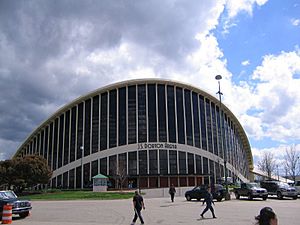
West Raleigh is home to North Carolina State University and Meredith College. You can also find Pullen Park and the North Carolina Museum of Art here. The Lenovo Center, where the Carolina Hurricanes play, is also in West Raleigh. This area is bordered by Cary to the west and south.
North Raleigh
North Raleigh is a large, growing suburban area. It has both older neighborhoods and many new housing developments. This area is mostly suburban with big shopping centers. Many major roads like Six Forks Road and Creedmoor Road serve North Raleigh.
South Raleigh
South Raleigh is along U.S. Route 401. It's the least developed part of Raleigh. This area has lower housing densities due to development rules. It borders towns like Cary and Garner.
Southeast Raleigh
Southeast Raleigh is next to downtown on its west side. It includes areas along Rock Quarry Road. The Coastal Credit Union Music Park is a major outdoor concert venue located here. Shaw University is also in this part of the city.
Raleigh's Weather and Seasons
Raleigh has four distinct seasons. Winters are generally cool, with temperatures often around 41.9°F (5.5°C) in January. It freezes about 69 nights a year. Raleigh gets about 46 inches (117 cm) of rain each year.
Summers are hot and humid. July temperatures average around 80.5°F (26.9°C). It can reach 90°F (32°C) or higher about 48 days a year. Autumn is similar to spring but can have very heavy rain from tropical storms.
Raleigh gets about 5.2 inches (13 cm) of snow each winter. Sometimes, there are ice storms that can cause damage. The biggest snowfall from one storm was 20.3 inches (51.6 cm) in January 2000.
Hurricanes can affect Raleigh in late summer and early fall. In 1996, Hurricane Fran caused a lot of damage from falling trees. Tornadoes also happen sometimes. A strong tornado hit parts of Raleigh in 1988, and another in 2011.
Population and People
| Historical population | |||
|---|---|---|---|
| Census | Pop. | %± | |
| 1800 | 669 | — | |
| 1810 | 976 | 45.9% | |
| 1820 | 2,674 | 174.0% | |
| 1830 | 1,700 | −36.4% | |
| 1840 | 2,244 | 32.0% | |
| 1850 | 4,518 | 101.3% | |
| 1860 | 4,780 | 5.8% | |
| 1870 | 7,790 | 63.0% | |
| 1880 | 9,265 | 18.9% | |
| 1890 | 12,678 | 36.8% | |
| 1900 | 13,643 | 7.6% | |
| 1910 | 19,218 | 40.9% | |
| 1920 | 24,418 | 27.1% | |
| 1930 | 37,379 | 53.1% | |
| 1940 | 46,879 | 25.4% | |
| 1950 | 65,679 | 40.1% | |
| 1960 | 93,931 | 43.0% | |
| 1970 | 122,830 | 30.8% | |
| 1980 | 150,255 | 22.3% | |
| 1990 | 212,092 | 41.2% | |
| 2000 | 276,093 | 30.2% | |
| 2010 | 403,892 | 46.3% | |
| 2020 | 467,665 | 15.8% | |
| 2023 (est.) | 482,295 | 19.4% | |
| U.S. Decennial Census 2010–2020 |
|||
In 2020, Raleigh had 467,665 people. The city is growing quickly. Many different groups of people live in Raleigh. About 51.6% of people are White, 25.76% are Black or African American, and 5.01% are Asian. About 12.94% of people are Hispanic or Latino.
The average household in Raleigh has about 2.30 people. The median age in 2000 was 31 years old. This means half the people were younger than 31 and half were older.
Religious Life in Raleigh
Raleigh has many different religions. Most people in Raleigh are Christian. The largest groups are Baptists, Methodists, and Roman Catholics. Other Christian groups are also present.
There are also people who practice Hinduism, Buddhism, Judaism, and Islam. Many religious organizations have their main offices in Raleigh.
Economy and Jobs
Raleigh has a strong economy with many different types of jobs. Key industries include financial services, electronics, medical equipment, and pharmaceuticals. Raleigh is a big part of North Carolina's Research Triangle. This area is a major hub for high-tech and biotech research. It's also known for advanced textile development.
The healthcare and pharmaceutical industries have grown a lot in Raleigh. Many companies in these fields are based here. In 2015, Forbes magazine named Raleigh the best place for businesses and careers.
Some well-known companies based in Raleigh include Red Hat, First Citizens BancShares, and Golden Corral. The North Carolina Air National Guard also has its headquarters in Raleigh. Experts say Raleigh has a lot of "brain power" because so many smart people live and work here. This helps the economy grow.
Major Employers in Raleigh
Here are some of the biggest employers in Raleigh:
- State of North Carolina (government jobs)
- Wake County Public School System (schools)
- WakeMed Health and Hospitals (healthcare)
- North Carolina State University (education)
- UNC Rex Healthcare (healthcare)
- Wake County (government jobs)
- City of Raleigh (city government jobs)
- Conduent Business Services
- Duke Energy Progress
- First Citizens Bank
Arts and Culture
Museums to Explore

Raleigh has many interesting museums for kids and families:
- Marbles Kids Museum: A fun, interactive museum for younger kids.
- North Carolina Museum of Art: This museum has a huge collection of art from around the world. It also has one of the largest outdoor art parks in the country.
- North Carolina Museum of History: Learn about North Carolina's past.
- North Carolina Museum of Natural Sciences: Explore science and nature. It has a giant globe called the Daily Planet.
- City of Raleigh Museum: Discover the history of Raleigh itself.
- J. C. Raulston Arboretum: A beautiful garden with plants from all over the world.
- Joel Lane House: Visit one of Raleigh's oldest homes.
- Mordecai Plantation: See historic buildings from an old plantation.
Downtown Raleigh also has many art galleries, like Art Space and Visual Art Exchange. CAM Raleigh shows new and modern art.
Performing Arts and Shows
Raleigh has many places to see live shows and concerts:
- Coastal Credit Union Music Park at Walnut Creek: A large outdoor venue for big concerts.
- Red Hat Amphitheater: Another outdoor spot for concerts, especially in summer.
- Duke Energy Center for the Performing Arts: This complex has several theaters for plays, operas, and concerts. It's home to the North Carolina Symphony and the Carolina Ballet.
- Raleigh Little Theatre: A community theater that puts on many plays.
You can also find smaller clubs and theaters that host different types of music and performances throughout the year.
Sports in Raleigh
Professional Sports Teams
| Team | League | Venue (capacity) | Since | Titles |
|---|---|---|---|---|
| Carolina Hurricanes | National Hockey League | Lenovo Center (18,700) | 1997 | 1 |
| North Carolina FC | United Soccer League | WakeMed Soccer Park (10,000) | 2006 | 1 |
| North Carolina Courage | National Women's Soccer League | WakeMed Soccer Park (10,000) | 2017 | 2 |
| Carolina Mudcats | Single-A (baseball) | Five County Stadium (6,500) | 1991 | 2 |
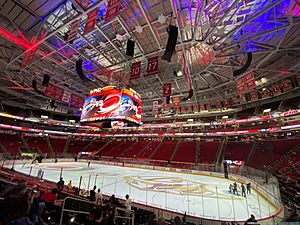
Raleigh is home to the Carolina Hurricanes, a professional ice hockey team. They play in the National Hockey League (NHL). The Hurricanes won the Stanley Cup in 2006, which was a huge achievement for North Carolina sports!
Other professional teams nearby include:
- North Carolina FC: A men's soccer team that plays in Cary.
- North Carolina Courage: A women's soccer team that also plays in Cary. They have won two championships.
- Carolina Mudcats: A minor-league baseball team that plays in the eastern suburbs.
College Sports
North Carolina State University (NC State) is in Raleigh. Their sports teams are called the Wolfpack. They compete in many different sports. The football team plays at Carter–Finley Stadium. The men's basketball team shares the Lenovo Center with the Carolina Hurricanes.
Parks and Outdoor Fun
Raleigh has over 200 parks and recreation spots! This includes 8,100 acres of park land. There are also 78 miles of greenway trails for walking and biking. You can find 22 community centers, tennis courts, and public lakes.
Pullen Park is the oldest public park in North Carolina. It has a carousel and other rides. The J. C. Raulston Arboretum is an 8-acre garden. It's open every day for free and has plants from all over the world.
Education in Raleigh
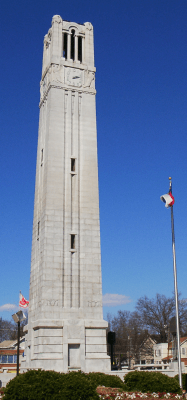
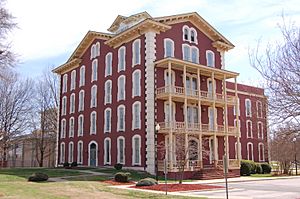
Raleigh is known as a very educated city. This is because of its many universities and the nearby Research Triangle Park.
Colleges and Universities
Public Universities
- North Carolina State University: A large public university with many different programs.
- Wake Technical Community College: Offers two-year degrees and training programs.
Private Colleges
- Campbell University School of Law
- Meredith College
- William Peace University
- Shaw University: A historic university founded after the Civil War.
- St. Augustine's University
Schools for Kids
Public Schools
Public schools in Raleigh are part of the Wake County Public School System. This is the largest school system in North Carolina. They try to make sure schools have a good mix of students from different backgrounds. Raleigh has several special high schools called magnet schools. These schools offer unique programs, like the International Baccalaureate program.
Some public high schools in Raleigh include:
- Needham B. Broughton High School
- Leesville Road High School
- William G. Enloe GT/IB Center for the Humanities, Sciences, and the Arts (a magnet school)
- Millbrook High School (a magnet school)
Charter Schools
Raleigh also has charter schools. These schools are public but run independently. Examples include Raleigh Charter High School.
Private Schools
There are many private schools in Raleigh, including religious schools. Some examples are:
- Grace Christian School
- North Raleigh Christian Academy
- Ravenscroft School
- St. David's School
- Cardinal Gibbons High School (Catholic)
- St. Mary's School
Media and News
Newspapers and Magazines
- The News & Observer: Raleigh's main daily newspaper.
- Independent Weekly: A free weekly newspaper covering local news and events.
- Midtown Magazine and Raleigh Magazine: Lifestyle magazines about Raleigh.
- Technician: The student newspaper for North Carolina State University.
Television and Radio
Raleigh is part of a large TV market. You can watch many local TV stations, including:
- WRAL-TV (NBC)
- WTVD (ABC)
- WNCN-TV (CBS)
- WRAZ-TV (Fox)
There are also many radio stations in Raleigh. They play different types of music, from country to hip hop, and offer news and talk shows.
Getting Around Raleigh
Air Travel
Raleigh–Durham International Airport (RDU) is the main airport for the area. It's located between Raleigh and Durham. RDU offers flights to many cities in the U.S. and other countries. About 15 million passengers use it each year.
Roads and Highways
Raleigh has several major highways:
- I-40: Connects Raleigh to Durham and other cities.
- I-440: This is the "Raleigh Beltline," a highway that goes around the central part of the city.
- I-540: This will be an outer loop around Raleigh when it's finished.
Trains and Buses
Raleigh Union Station is a busy train station. You can take Amtrak trains from Raleigh to cities like Charlotte, New York City, and Miami.
Raleigh has a public bus system called GoRaleigh. It has many bus routes around the city. There's also GoTriangle, which offers bus service between Raleigh and nearby cities like Durham and Chapel Hill. North Carolina State University has its own bus system called the Wolfline, which is free to ride.
Biking and Walking
Raleigh is becoming more bicycle-friendly. Many buses have bike racks. You can also use Raleigh's greenway system, which has paths and trails for biking and walking all over the city. In 2011, Raleigh was named a "Bicycle Friendly Community."
Sister Cities
Raleigh has several "sister cities" around the world. These are cities that have special partnerships to promote cultural and economic ties:
 Compiègne, France
Compiègne, France Xiangyang, China
Xiangyang, China Kingston upon Hull, United Kingdom
Kingston upon Hull, United Kingdom Rostock, Germany
Rostock, Germany Nairobi, Kenya
Nairobi, Kenya Gibraltar, Gibraltar
Gibraltar, Gibraltar
Images for kids
See also
 In Spanish: Raleigh para niños
In Spanish: Raleigh para niños


